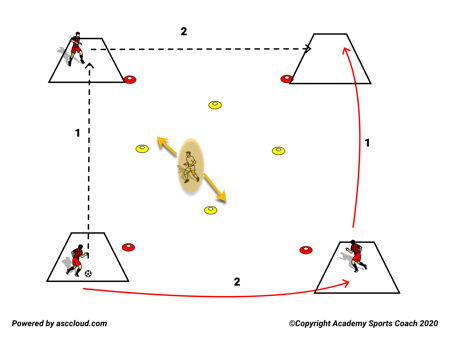In this version, the defender is confined to a diamond-shaped zone within the grid for social distancing purposes. The idea is that the defender will be responding to the movement of the ball by shifting position in the zone. Because the instruction for the attacking players is to move the ball on the edges of the grid, the defender will not have an opportunity to win the ball.
The defender’s movements are intended to provide a cue to the player on the ball – consider the position of the defender and play out of pressure. The defender should be positioned to either one side or the other, as shown below:

We want the defender to pick one side or the other. If the defender is positioned in the middle, then either of the two teammates of the player on the ball is an option.
We will want to observe the footwork and body shape of the defender. Ideally, we are looking for the defender to retain an athletic position, use quick movements with relatively short steps, avoid crossing feet, and maintain vision on the ball. The size of the grid and the attackers’ quality will dictate the defender’s success, where success is defined by the ability to engage the player on the ball continuously.
As with any activity, we should have an idea the picture we are looking for. The details of the picture will depend on the age and ability of the players. The size of the grid and defender zone will have a significant impact on the outcome.
With younger players, we would look for the recognition of off-ball movement by the attackers, the decision making of the player on the ball, and the use of scanning by all players. Also, with older players, we would expect a higher priority on the touches and passes’ quality.
In the execution of the activity, three types of observation would dictate changes.
- The activity is moving too slowly – there is too much time spent on the ball, teammates are standing and waiting
- The activity is sloppy – too many poor decisions
- The defender has checked out – is putting in enough effort to reengage when the ball is passed
Before we talk about how we would respond to these observations, we need to discuss a fourth possible observation – the teammates off the ball are not moving to a supporting position when the ball is passed. With both older and younger players, the 3rd man support is a primary objective. If the support isn’t happening or is happening too slowly, we may want to consider verbal encouragement, rehearsals, and dialog. Verbal encouragement should be limited and focused – I have used the phrase “where do you go” rather than saying “run now”, “go left,” etc. A rehearsal can involve a pass of the ball and then questioning the players, “what happens next.” A dialog can include questions such as “how is it going,” “what’s working,” “what can we do differently.”
If the activity is moving too slowly or the activity is sloppy, we may want to consider changing the size of the grid. If play is slow, we can make the grid smaller – this will allow the 3rd player support to arrive sooner. If play is sloppy, we may want to make the grid larger to improve quality by providing more time.
In the original activity, the defender zone is entirely within the grid, and the defender will have no opportunity to intercept the ball. Frequent rotation of players through the defender role may keep the activity fresh and allow players to stay engaged. A clear definition of success for the defender – the desired coaching points and verbal encouragement for the defender – can also help.
A change to the shape of the activity can help the defender’s connectedness and provide a quality progression for all players. Expanding the size of the defender zone to overlap with the grid edges allows the defender to potentially challenge passes and forces the attackers to angle their runs:

Social distancing requires minimum spacing between players. The expansion of the defender zone should result in the attackers using different movement patterns than the “straight” run, which many attackers will choose. Allowing the defender to challenge the ball creates new problems for the attackers and encourage competition.
Our 3v1 is a gateway to more sophisticated activities. We introduce some basic movement patterns, decisions on the ball, and responsibilities for the defender. The size of the grid and the defending zone will have an important influence on the pictures created by the players. Coaching encouragement, rehearsals, and dialogs can support the ability of the players to respond to the challenges in the activity. Continual scanning of the environment by the players is an important aspect of the activity and is integrated into our Principles of Play.
We must reflect in real-time on our players’ ability to express the behaviors that we are looking for when we design an activity. We need to understand how the activity should look and what we expect our players to learn. If the players are not successful, we need to consider how we can change the environment to suit their ability. Sometimes, a small change will unlock the activity and result in the players switching on. Understanding the effects of our changes will help us learn from the players and – hopefully – improve the quality of future training sessions.